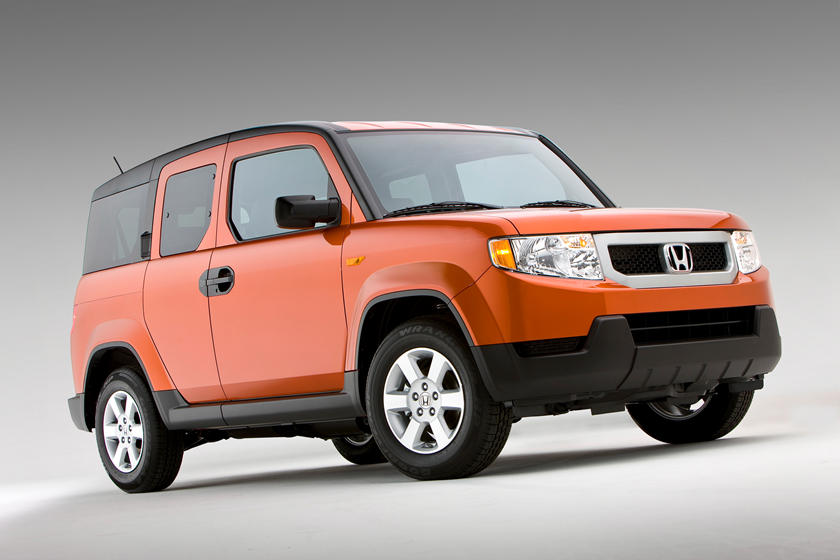by Aiden Eksteen
The Honda Element is an anomaly within the compact SUV segment as the one that initiated the polarizing box-car design later used by nameplates such as the Kia Soul and the Nissan Cube. It was introduced in 2003 soon after the late generation CR-V on which its platform is now based. Powering either its 2WD or 4WD system is a 2.4-liter four-cylinder engine with 166 horsepower and 161 lb-ft of torque, mated to a five-speed automatic gearbox. The new Honda Element is a spacious and decently practical daily commuter. It's also a decently capable off-road SUV, beneficial for those camping getaways. Unfortunately, 2011 marks the final year of the nameplate's production in the USA.
See trim levels and configurations:
Most people would agree that the box-car shape isn't the most attractive, especially for an SUV. This is the style Honda decided to accord to the Element nonetheless. Honda formulated it to target young, single males who are sporty, social, and well-traveled. The older generation has, however, taken more of a liking to it with how practical its shape actually makes it. Squared front halogen headlights with DRLs are standard-fit across the board. Between them is a prominent grille underscored by a large lower air intake and a black bumper. Its chassis is slightly lifted for added capability, supported by 16-inch steel wheels with full covers on the LX or 16-inch alloys on the EX.
For 2011, all Honda Element models come equipped with a single powertrain composition - a 2.4-liter 4-cylinder i-VTEC unit mated to a stock five-speed automatic transmission. Outputs are rated at 166 horsepower and 161 lb-ft of torque. A typical 2WD system is stock-fitted in both variants with a Real-Time 4WD configuration optionable. Unfortunately, this mill isn't ideal; it's discernibly fettered by the vehicle's proportions and weight and can be lethargic when pushed to reach higher speeds for merging or overtaking. It develops all of its power at the top end of its rev range, so the pilot really has to put their foot down to move anywhere quickly. Independent testers have seen the Element clear the 0-60 mph sprint in around ten seconds. Though no official rating is given for towing, most owners agree that the Element has a max towing capacity of 1,500 lbs.
Unlike the Honda CR-V, which actually feels more like a regular car, the Element's size and weight have it feel bigger than it really is on the road. This is most noticeable at higher speeds and when maneuvering through tight corners and parking lots. With that said, however, its hydraulic steering is surprisingly precise, delivering quick and accurate responses. In terms of ride quality, it's reasonably comfortable in urban settings. It's very settled and soft most of the time, which is exactly what you want from a daily commuter. It's got some mild off-roading capability, too, but it's 4x4 setup is by no means purposed for any true 4x4 application. Its rugged exterior and raised ride height make it ideal for campers.
EPA gas mileage estimates for the Element are relatively poor for its classification. In 2x4 guise, the Element returns figures of 20/25/22 mpg on the city/highway/combined cycles. With the 4x4 setup in play, fuel economy figures drop to 19/24/21 mpg.
The interior carries a purposed utilitarian yet dated impression. It's designed for the active lifestyle and, as such, features plenty of hard-touch materials. The layout is very simplistic and easy to gauge but the fit and finish could be better. It's still acceptably comfortable on the inside. The floor is covered in a urethane layering and the seats fold up to the side, making the interior easy to wash down. Outward visibility is exceptional thanks to large windows all-round, and the boxy shape of the inside also allows for ample passenger room throughout. The only qualm here is that there is no foot space provided for occupants in the back. There are also several storage points and, with no 3rd-row, cargo space is plentiful.
Standard specs in the LX include a multi-function steering wheel, a driver's seat with manual height adjustment, and manual air conditioning. Seats are upholstered with a water-resistant FXC fabric. Front seats can fold down completely flat and the rear bench can flip-up and is removable. The stock AM/FM/CD-compatible stereo has four speakers - in the EX, it's upgraded with seven speakers, MP3/WMA-compatibility, XM radio, and an auxiliary input jack. In terms of protection, all Element models come equipped with six airbags and the essentials such as ABS, EBD, stability and traction control, and a TPMS.
Though the NHTSA hasn't reviewed the Honda Element for its crashworthiness, the IIHS's review of the 2011 Honda Element turned out good results. Of the four specified tests that the IIHS typically use to evaluate vehicles for their crashworthiness, the Element earned the best possible scores of Good in each - subsequently earning it a Top Safety Pick position.
You receive decent performance at the Element's price, but that's about it. The overall aesthetic is otherwise plain and functional, while inclusive features are minimal, as are packages and options. The LX trim goes for sale at an MSRP of around $21,000 with the EX trim coming in at around $25,000. Unlike Honda's other cars, the Element stands out for its polarizing styling, giving it a sense of exclusivity that actually compounds on the brand's utilitarian ethos. It's a workable ute, one that's comfortable on-road and semi capable off-road. It's aging, however, and there are many better SUVs in the compact segment. This will be the last year anyone can acquire a new Element, though, so unless you're okay settling for a used variant, buy now.
The most popular competitors of 2011 Honda Element:





